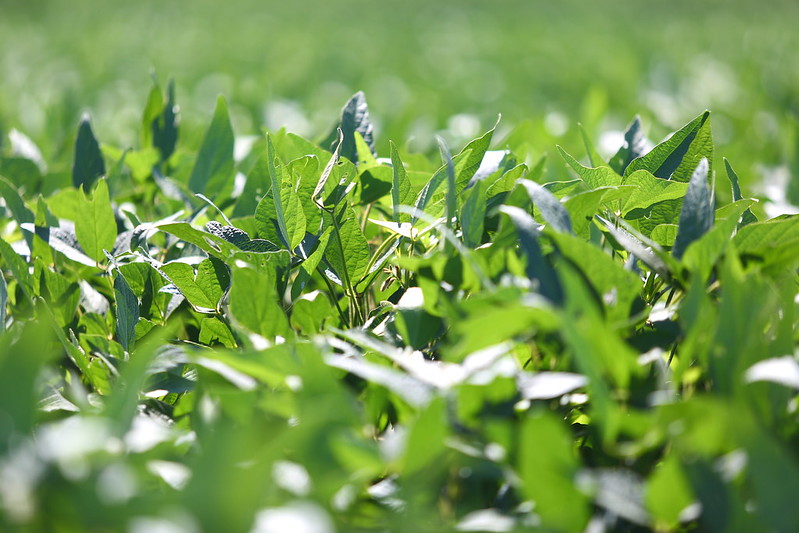Sept. 11, 2020
China makes series of high-volume purchases of U.S. soybeans; sales up 20 percent over last year
By Ryan McGeeney
U of A System Division of Agriculture
Fast Facts:
- China making series of large soybean purchases from U.S. as it shifts from Brazilian exports
- China still lags behind expectations set by Phase One agreement
- Massive damage to Iowa soybean acreage may improve Arkansas market standing in coming year
(601 words)
(Download this story in MS Word format here.)
LITTLE ROCK — In a year that has otherwise been a tough slog for soybean producers and other farmers in the United States, a silver lining emerged this week: China, the world’s largest importer of soybeans and many other commodities, booked purchases of about 644,000 metric tons of U.S. soybeans for delivery in the 2020-2021 marketing year, according to the U.S. Department of Agriculture.
The purchase is approximately equal to 24 million bushels.
Scott Stiles, extension economist for the University of Arkansas System Division of Agriculture, said that while the single-day purchase is notably large, it wasn’t quite record-breaking, and the timing was in keeping with normal cycles.
“China typically sources their soybeans from Brazil from late January through August or September,” Stiles said. “Once their supplies are exhausted, they usually begin sourcing them from the United States. They’ll buy from us through January or so, whenever the Brazilian harvest gets in the export pipeline.”
While the purchase is not inherently part of the “Phase One” U.S.-China trade agreement, which went into effect in February of this year, it will count toward fulfillment of those obligations, Stiles said.
The USDA requires U.S. exporters to report any single-day sale of 100,000 tons or more of a single commodity. So, while “the public doesn’t necessarily see every purchase made by a foreign buyer,” Stiles said, “there have been weeks recently where China is making a significant purchase every day.”
According to the USDA, China is projected to import approximately 99 million metric tons of soybeans in the 2020-21 marketing year, or more than 8 million metric tons each month, on average. The September purchase is the latest in a string of large purchases from China.
According to the U.S.-China trade agreement, China committed to an annual purchasing target of $36.6 billion in U.S. agricultural products. As of July, China had purchased only about $9.9 billion in U.S. agricultural products, well behind its year-to-date target of about $21.3 billion, according to the Peterson Institute for International Economics.
The 2019-2020 marketing year did mark a 20 percent increase in U.S. soybean sales to China, jumping from about 14.2 million metric tons during the 2018-2019 year to more than 17 million metric tons, according to the USDA Export Sales report, released today. Also of note is the tremendous increase in new crop soybean sales to China compared to the same period a year ago — 15.4 million metric tons for the 2020-2021 marketing year, versus about 864,295 metric tons in September 2019.
While the soybean purchase is not specifically a boon to Arkansas growers, Stiles said the state’s proximity to the Gulf of Mexico is an advantage.
“Most of our soybeans are earmarked for export, one year to the next,” he said.
And while Arkansas growers have had their own weather challenges to deal with, growers in other states have had it worse. In August, a windstorm known as a derecho pulverized about 14 million acres of farmland in Iowa, damaging more than 5.6 million acres of soybean — more than half the 9.1 million acres the state planted in 2019 — and more than 8 million acres of corn.
Stiles said the impact of the derecho event won’t truly be known until harvest is complete. In a Crop Production Report released today, the USDA’s National Agricultural Statistics Service adjusted its forecast for U.S. soybean production down 3 percent from previous forecasts to 4.31 billion bushels, with an average record high of 51.9 bushels per harvested acre.
According to the report, Arkansas growers are projected to average 49 bushels per acre, with total 2020 production of about 142.6 million bushels.
To learn about extension programs in Arkansas, contact your local Cooperative Extension Service agent or visit www.uaex.uada.edu. Follow us on Twitter at @UAEX_edu.
About the Division of Agriculture
The University of Arkansas System Division of Agriculture’s mission is to strengthen agriculture, communities, and families by connecting trusted research to the adoption of best practices. Through the Agricultural Experiment Station and the Cooperative Extension Service, the Division of Agriculture conducts research and extension work within the nation’s historic land grant education system.
The Division of Agriculture is one of 20 entities within the University of Arkansas System. It has offices in all 75 counties in Arkansas and faculty on five system campuses.
Pursuant to 7 CFR § 15.3, the University of Arkansas System Division of Agriculture offers all its Extension and Research programs and services (including employment) without regard to race, color, sex, national origin, religion, age, disability, marital or veteran status, genetic information, sexual preference, pregnancy or any other legally protected status, and is an equal opportunity institution.
# # #
Media contact:
Ryan McGeeney
Communications Services
University of Arkansas System Division of Agriculture
Cooperative Extension Service
(501) 671-2120
rmcgeeney@uada.edu
